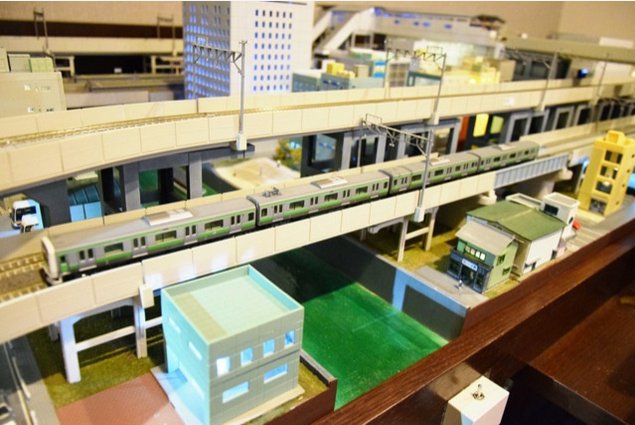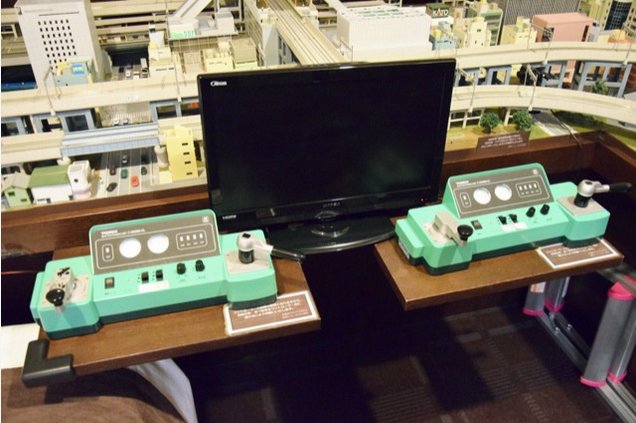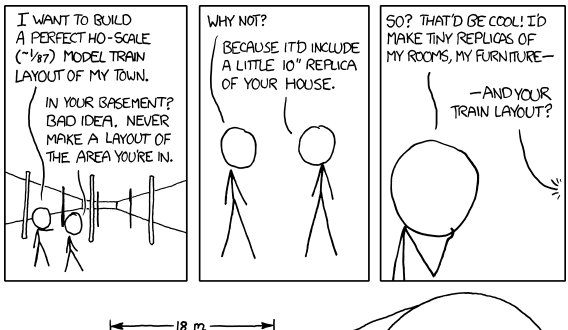Published on 14 Jun 2017
The future of train transportation might be pneumatic tubes and magnets. Meet the 89-year old entrepreneur who wants to disrupt the railroad with a modern twist on a very old train idea.
June 30, 2017
Meet the 89-Year Old Who Built a Train in His Backyard | WIRED
January 7, 2017
James May The Reassembler S02E01 Christmas Hornby Train Set
Published on 28 Dec 2016
James May is back in his shed, reassembling a Hornby (or is it) train set
December 18, 2015
HP Lovecraft’s model railway
Well, not actually his railway, but a layout built by John Ott portraying the world in which HP Lovecraft’s stories were set:
“[T]he ancient, mouldering, and subtly fearsome town… witch-cursed, legend-haunted Arkham, whose huddled, sagging gambrel roofs and crumbling Georgian balustrades brood out the centuries beside the darkly muttering Miskatonic.”
—HP Lovecraft, “The Thing on the Doorstep”It’s a shame your layover is so short, Howard. There’s not much time to look around. Not enough time to see Miskatonic University across the river, though I’m sure you’re familiar with what ivy-covered halls look like. You’re planning on going to Brown someday yourself, aren’t you, young man? Well, at any rate— you’ll have to stick around with me downtown, close to the station, and see what you may. Arkham is an… interesting place, even though it might not be apparent to the casual traveler.
We might be known for them, but you won’t find many gambrel roofs or decaying Georgian mansions downtown. Arkham is a prosperous modern city. Well… that is… it’s a once-prosperous city that still cherishes dreams of a bright future. Let’s just leave it at that.
And… oh yes, about all that stuff you’ve heard. You know… the things they say about Arkham. Strange cults, witches’ curses, child sacrifice… odd things. Well, remember it’s the year nineteen-hundred-and-seven Anno Domini. Those kinds of things just don’t happen any more. Arkham is a normal, quiet place. Very typical for eastern Massachusetts. Really.
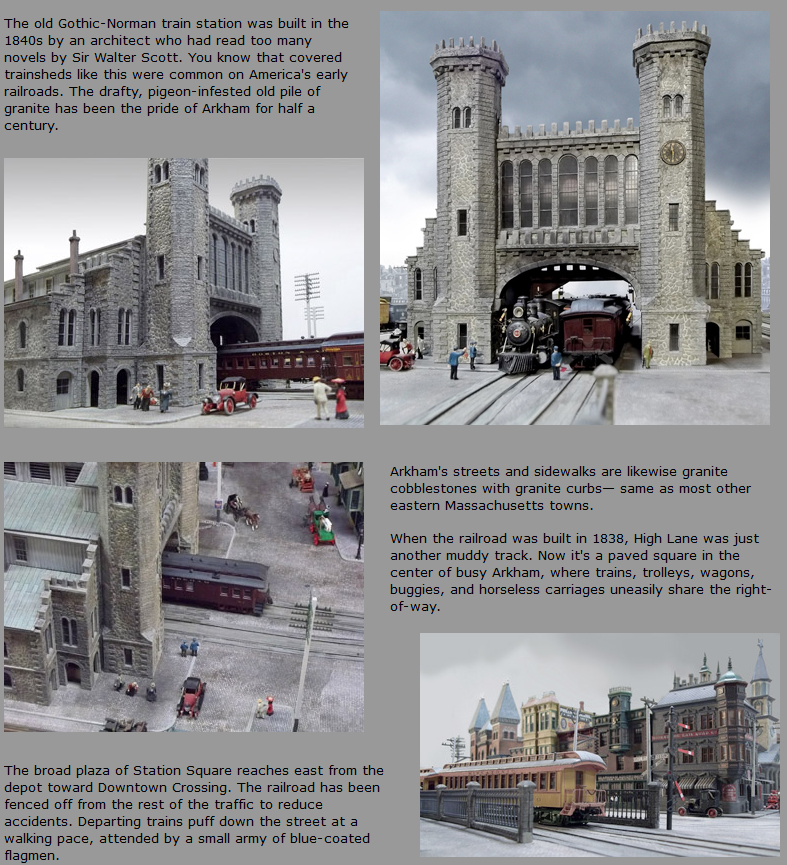
H/T to Cory Doctorow for the link.
April 4, 2015
Pete Waterman’s £1 million model railway collection
Model railways can get expensive, but they don’t normally get into seven figures (and that’s approximately one-tenth of the total value):
Pete Waterman’s indelible links with pop empires and reality television overlook the personal vocal abilities of the mogul himself. In the late 1960s, when his infatuation with trains and their miniature replicas began, he funded his acquisitions by starting the flying choir — a venture in which his singing entertained wedding-goers at different churches across Coventry on Saturdays, earning 10/6 a time.
A guinea a week from his paper round and “five bob” from fetching coal in his sister’s pram also helped him replicate the sights he would witness from the tracks stretching past his childhood home. “When you live in a council house and these things go past your door, it’s your first encounter with beauty,” recalls the man whose collection, according to auctioneers Dreweatts, is of “incalculable” value 56 years in.
“There were people sitting with white tablecloths and table lamps having dinner. It was magical. Think of the contrast: we didn’t even have glass in the windows at home.
“I set out to create the best, and I have done for railways what some people have done for model cars and planes.”
Waterman is about to put £1 million of his scratch-built model trains under the hammer in Mayfair. It’s only a tenth of the full collection, but selling the live steam and 10mm to foot-scale models will raise enough to safeguard his full-size steam engines, held around the country under the direction of the Waterman Railway Heritage Trust.
“These full-size engines won’t be back in steam for ten years,” he admits. “I’m 68 now and this is probably the last chance I will have to restore the engines held by the trust. So I’m making sure there is enough money in ten years’ time to continue the job.”
Besides, he feels the artefacts going on sale are somewhat anomalistic. “They no longer fit into the wider collection. It’s almost like I was into Pre-Raphaelite art and I’m now a modernist.”
March 21, 2015
British journalist mourns the loss of innocence in model railway layouts
From the tone of Mr. Simkins’ “shocked-and-horrified” tone, I can only assume he’s been in a coma since roughly 1967:
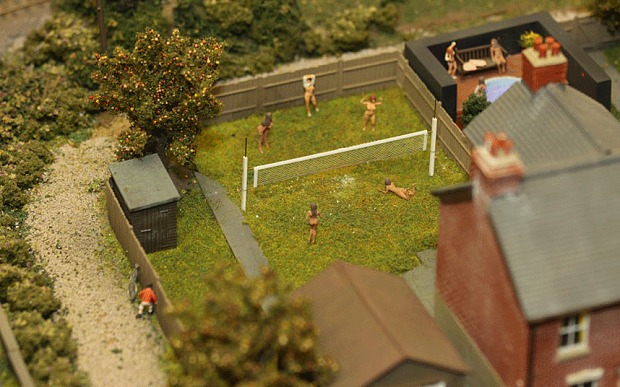
I’d always considered the world of model railways to be the last surviving example of a rose-tinted Britain that no longer exists. Enthusiasts of this quaint and captivating hobby invariably seem to use 1950 as their cultural template when designing their layouts.
In the real world it may all be Pendolino trains, gleaming concourses in steel and glass, and rail replacement bus services; but in model railwayland you’d always find puffing steam trains barrelling along in front of an idealised balsawood countryside that was never far from Adlestrop.
And therein, of course, lay their charm. Whenever I visited an exhibition I always revelled in the tiny trackside details as much as the engines themselves: the miniature sheep, the artificial grass, the miniature coal lorries waiting at the level crossing, and the old-fashioned station platforms.
Best of all, I loved the human figurines awaiting the arrival of the train they’re destined never to board. In the world of model railwayland, fashion as well as technology seemed to have stopped around the end of rationing, with each tiny passenger clad in pleated skirts or duffel coats.
But now an enterprising model railway emporium in Devon is set to shatter this cosy fictional world. Buffers of Axminster is selling a new range of steamy miniature figurines to reflect the laid-back (literally in some cases) attitudes and cultural mores of modern Britain.
They may be new to Mr. Simkins, but scale figures of nudes have been available as long as I can remember (although North American ads for them had to be careful not to expose too much scale detail, for fear of offending the postal authorities…)
H/T to Elizabeth for the link.
December 3, 2014
The Tech Model Railroad Club’s role in the rise of the hacking community
Steven Levy talks about one of the less likely origins of part of the hacking world — MIT’s model railroad club:
Peter Samson had been a member of the Tech Model Railroad Club since his first week at MIT in the fall of 1958. The first event that entering MIT freshmen attended was a traditional welcoming lecture, the same one that had been given for as long as anyone at MIT could remember. LOOK AT THE PERSON TO YOUR LEFT … LOOK AT THE PERSON TO YOUR RIGHT … ONE OF YOU THREE WILL NOT GRADUATE FROM THE INSTITUTE. The intended effect of the speech was to create that horrid feeling in the back of the collective freshman throat that signaled unprecedented dread. All their lives, these freshmen had been almost exempt from academic pressure. The exemption had been earned by virtue of brilliance. Now each of them had a person to the right and a person to the left who was just as smart. Maybe even smarter.
There were enough obstacles to learning already — why bother with stupid things like brown-nosing teachers and striving for grades? To students like Peter Samson, the quest meant more than the degree.
Sometime after the lecture came Freshman Midway. All the campus organizations — special-interest groups, fraternities, and such — set up booths in a large gymnasium to try to recruit new members. The group that snagged Peter was the Tech Model Railroad Club. Its members, bright-eyed and crew-cutted upperclassmen who spoke with the spasmodic cadences of people who want words out of the way in a hurry, boasted a spectacular display of HO gauge trains they had in a permanent clubroom in Building 20. Peter Samson had long been fascinated by trains, especially subways. So he went along on the walking tour to the building, a shingle-clad temporary structure built during World War II. The hallways were cavernous, and even though the clubroom was on the second floor it had the dank, dimly lit feel of a basement.
The clubroom was dominated by the huge train layout. It just about filled the room, and if you stood in the little control area called “the notch” you could see a little town, a little industrial area, a tiny working trolley line, a papier-mache mountain, and of course a lot of trains and tracks. The trains were meticulously crafted to resemble their full-scale counterparts, and they chugged along the twists and turns of track with picture-book perfection. And then Peter Samson looked underneath the chest-high boards which held the layout. It took his breath away. Underneath this layout was a more massive matrix of wires and relays and crossbar switches than Peter Samson had ever dreamed existed. There were neat regimental lines of switches, and achingly regular rows of dull bronze relays, and a long, rambling tangle of red, blue, and yellow wires—twisting and twirling like a rainbow-colored explosion of Einstein’s hair. It was an incredibly complicated system, and Peter Samson vowed to find out how it worked.
There were two factions of TMRC. Some members loved the idea of spending their time building and painting replicas of certain trains with historical and emotional value, or creating realistic scenery for the layout. This was the knife-and-paintbrush contingent, and it subscribed to railroad magazines and booked the club for trips on aging train lines. The other faction centered on the Signals and Power Subcommittee of the club, and it cared far more about what went on under the layout. This was The System, which worked something like a collaboration between Rube Goldberg and Wernher von Braun, and it was constantly being improved, revamped, perfected, and sometimes “gronked” — in club jargon, screwed up. S&P people were obsessed with the way The System worked, its increasing complexities, how any change you made would affect other parts, and how you could put those relationships between the parts to optimal use.
February 16, 2014
Hotel room with a built-in model train layout
Another case of Japan finding a niche clientele, this time in specialized hotel accommodation:
A Hotel Room Where Train Nerds Can Get Action. Train Action.
In most Japanese hotel rooms, you just sleep. In some, you might do other things. But in this Tokyo hotel you can play with toy trains.
At the Washington Hotel in Tokyo’s geek district of Akihabara, room 1304 is quite different from the rest. It’s outfitted with a diorama that has Tokyo Tower, Tokyo Skytree, and thirty meters of model train track!
H/T to Jeff Shultz for the link.
May 15, 2013
Google UK marks the 150th birthday of Frank Hornby
If you go to https://www.google.co.uk/ today, you’ll see the Google doodle has a distinct toy train motif:
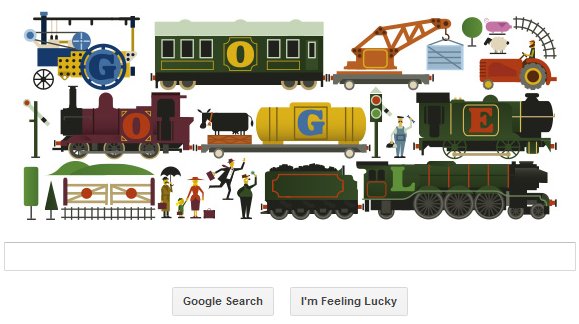
At The Independent, Matilda Battersby tells the story:
The search engine Google is celebrating the 150th birthday of visionary toy maker Frank Hornby, whose model railways, Meccano sets and Dinky toys are still being played with by children today.
Born in Liverpool on 15 May 1863, Hornby was behind three of the most popular toy lines of the 20th century despite having no formal engineering training.
[. . .]
Meccano’s turnover for the 1910 financial year was £12,000. His son Roland joined the business, and when the operation began exporting to Europe, he opened Meccano France Ltd in Paris. Two offices in Germany soon followed.
Having dabbled in politics in later life, Hornby died of a heart condition and diabetes in Maghull, near Liverpool, on 21 September 1936. Two years previously he had set up Dinky Toys to manufacture miniature model cars and trucks.
In 1938 his son Roland launched the Hornby Dublo model railway system — a posthumous honour to his father.
Enthusiasts around the world still collect Hornby train sets, Dinky Toys and Meccano models. The modern business also make Scalextric cars and Airfix kits.
H/T to Roger Henry for the link.
June 30, 2011
xkcd: The first rule of model train layouts
Jon sent me a link to this xkcd strip, which still amuses me:
June 12, 2011
Montreal model railway loses out to real railway
Canadian National, which owns the building hosting Montreal Model Railway Club — claimed to be “Canada’s largest fully operational model railway” — is terminating the club’s lease because they can get higher rent for the building:
In a warehouse in Montreal’s historic Griffintown neighbourhood, model train enthusiasts have spent 38 years engaging in a labour of love.
Inch by inch, they’ve constructed what is believed to be Canada’s largest fully operational model railway.
More than 300 people have participated over the years, devoting thousands of hours to building life-like models across an eye-popping, detail-laden, 1,493-metre masterpiece.
And it’s about to be detroyed.
The reason for the imminent dismantling is not without irony: the make-believe trains are about to be forced away by a real train company, dealing with real-life issues like rising property costs.
Canadian National owns the 9,000-square-foot warehouse space and wants to lease it out at a higher rent, starting next year. It warned the model-train association five years ago that its time was up.
The club’s website is http://www.canadacentral.org/Reseau_EN.htm.
February 21, 2010
It sounds like the correct answer to the legal question
It’s surprising that a dispute over the use of open source software in a model railway application would be the one to set the legal precedent, but that is what happened here:
Although some people viewed it as a tempest in a teapot, the long-running legal case Jacobsen v. Katzer stirred up some seminal open source issues. We first reported on the dust-up all the way back in August of 2008, noting that the dispute centered around — of all things — model train software.
Specifically, Jacobsen had developed JMRI, the Java Model Railroad Interface project. When Katzer built the code for the project into proprietary model train software, deleting existing copyright notices within the code, Jacobsen filed suit. Now, settlement documents are available online, and the end of the dispute points to a final victory for open source licenses.
The settlement documents show that Katzer will pay Jacobsen $100,000 over 18 months, cease using the JMRI code, and not attempt to register domains using the JMRI name. Previously, the legal dispute had gone all the way to the United States Court of Appeals for the Federal Circuit, which is the last legal stop before the Supreme Court. As Lawrence Lessig noted in a post, when the Court of Appeals upheld the Artistic License that governed the use of JMRI, it was “an important victory” for free licenses. Lessig noted that the decision had broad implications for many open source licenses.
Just because someone allows the use of source code freely does not mean you can, in effect, file off the serial numbers and pretend that it’s all your own work . . .
H/T to Craig Zeni for the link.
August 27, 2009
Kids will be kids
Even when they’re adults . . . James May tried to set a record, but the kids just got in the way:
An attempt by Top Gear‘s James May to break the world’s longest model railway record has failed amid claims that vandals and thieves tampered with the track.
The long-haired presenter joined 400 enthusiasts to build the miniature railway stretching 10 miles from Barnstaple to Bideford, in North Devon.
He was recording the attempt yesterday for his new show James May’s Toy Stories.
The team hoped that a train would run successfully along the length of the track, built on the picturesque Tarka Trail.
But their hard work was hampered as parts of the track were taken and coins dropped on the line, blowing the battery. Even the battery was stolen.
H/T to Jeff Shultz.


